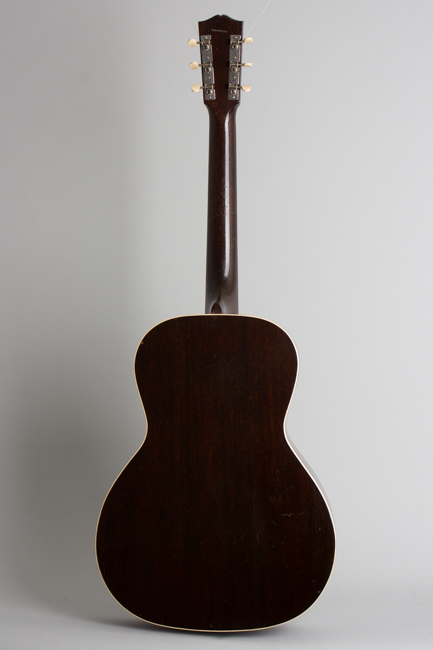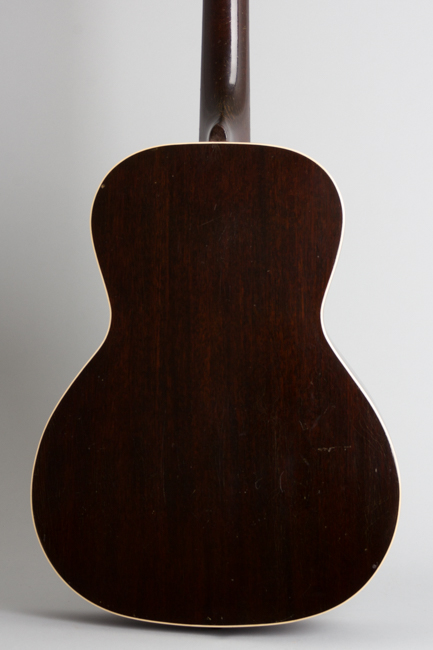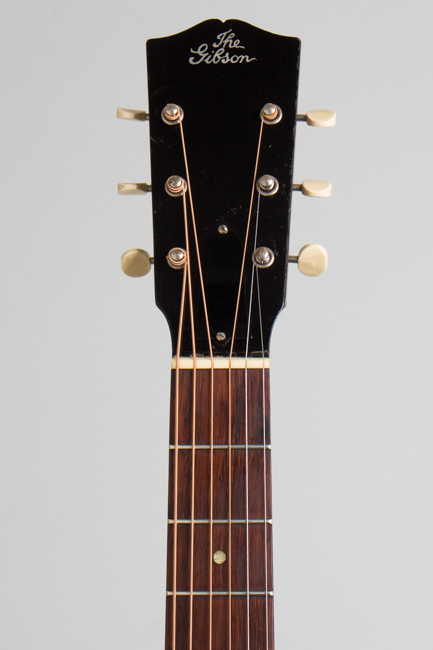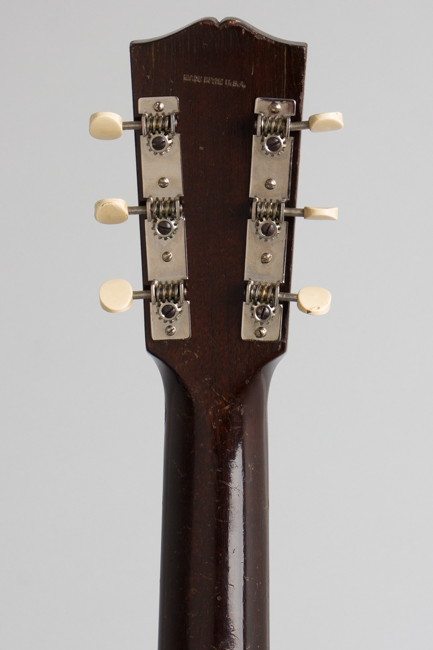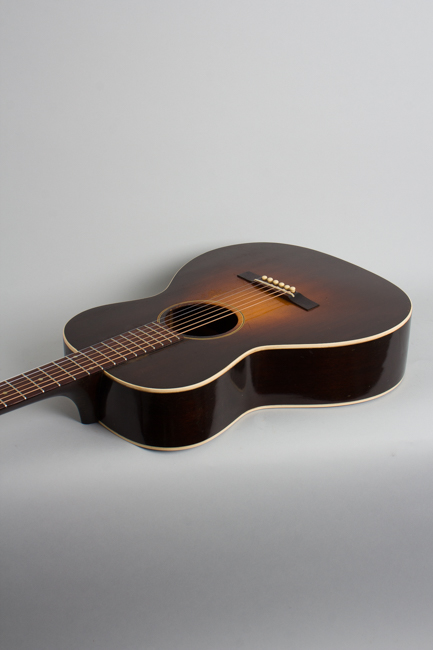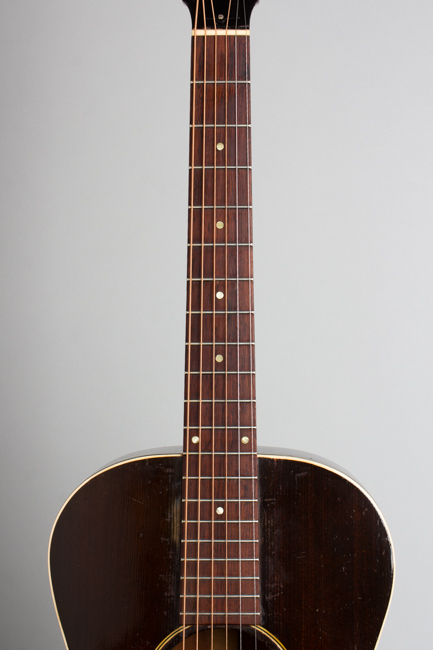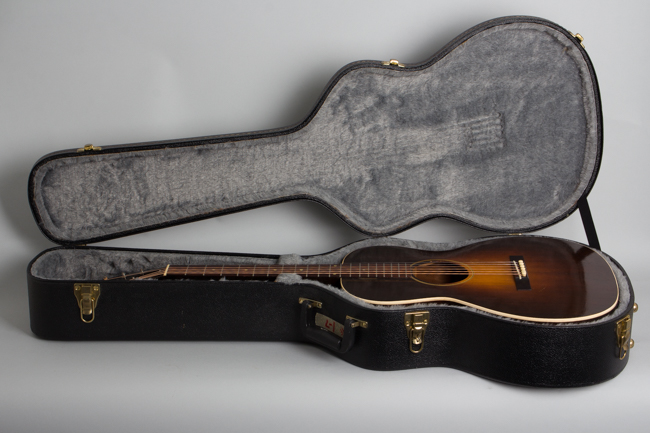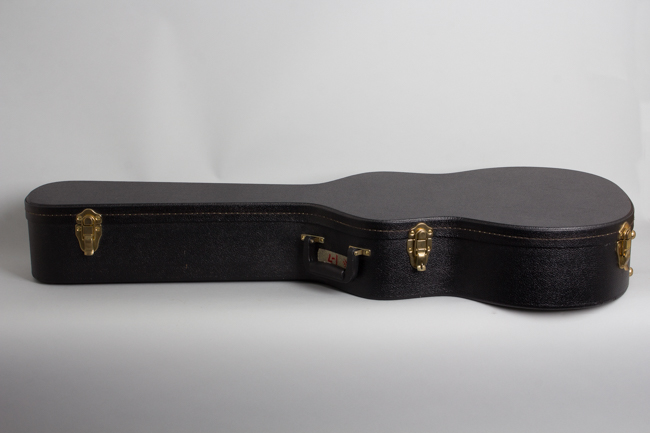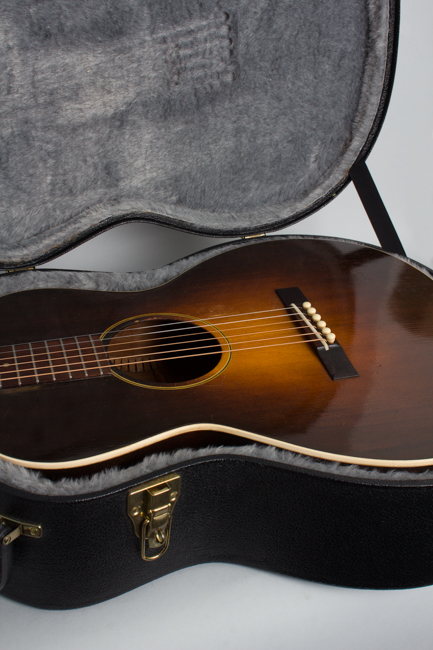Gibson L-1 Flat Top Acoustic Guitar (1931)
This item has been sold.
Item # 11166
Prices subject to change without notice.
Gibson L-1 Model Flat Top Acoustic Guitar (1931), made in Kalamazoo, Michigan, serial # 9983, sunburst top, dark back and sides finish, mahogany back and sides, spruce top; mahogany neck with rosewood fingerboard, black hard shell case.
This is a fine playing and generally well preserved example of a rare and wonderful Gibson flat-top, the 1929-31 L-1. This version of the model with a 12 fret neck was only produced for that brief period before being modified to a 14-fret design. This 1931 L-1 mixes features from earlier and later eras into a unique package, with the elegant look of the 1920s Gibsons on the larger body of a more "modern" 1930s flat-top guitar.
The nearly 15" wide, less round-bottomed mahogany body on this guitar was introduced in 1929 replacing an earlier, smaller design built on Gibson's 1910's L-1 archtop pattern. The X-braced spruce top was also a new addition, first employed around 1928 on this model. These features would continue to be used on large numbers 14-fret L-series guitars throughout the 1930s. This 1931 model retains the beautiful older-style hand-rubbed Cremona brown sunburst finish on the top and small silver script "The Gibson" logo on the headstock, both of which were gone by 1932.
These 12-fret L-1s feature exceptionally light construction, even compared to other pre-war Gibsons like the far more common mid-1930s examples. The X bracing is quite delicate, with thinner main braces than even Martin used at the time. The neck is very comfortable, surprisingly slim with a shallow "C" profile, worlds away from the heavy "V" that Gibson adopted for the 1933-39 L-series flat tops. The strings have more taper towards the bridge than many similar instruments making this model an ideal fingerpicking guitar.
While we are partial to all pre-WWII Gibson flat-tops, we find the L-1's from this period to be a particularly attractive-looking and always great-sounding guitars. These delicately built 12-fret 14 3/4" L-1s were made in fairly limited numbers, and few survive in as solid condition as this one. At $50 they were fairly expensive for the time, and Gibson sales were blighted anyway by the deepening Depression. This one has a small stamp "made in the USA" on the back of the headstock indicating it was originally sold as an export model. Every survivor we have found has proved a gem, with a powerful sound for a small body instrument, a delight to play in any style.
Overall length is 38 1/2 in. (97.8 cm.), 14 3/4 in. (37.5 cm.) wide at lower bout, and 4 1/4 in. (10.8 cm.) in depth at side, taken at the end block. Scale length is 24 3/4 in. (629 mm.). Width of nut is 1 11/16 in. (43 mm.).
This is a generally well-preserved example of this extremely lightly built instrument, showing some wear and maintenance repair but an excellent player especially for being over 90 years old. Except for a few tiny touch-ups on the rim the thin lacquer finish is all original. There is some wear through the top finish, mostly to the common spots just below the strings. The thin lacquer shows checking overall, most heavily to the top with a particularly noticeable spot on the lower treble bout below the bridge. Overall there are a number of small scrapes, dings and dents but no particularly heavy wear. The finish remains quite attractive, with a the subtle hand-rubbed look to the small 'burst area on the top.
Many of these very lightly built instruments have been heavily rebuilt over the decades. This one has had a somewhat larger rosewood bridgeplate added in place of the tiny maple original, but that is the only alteration. The rest of the interior remains original; the very thin braces are completely solid with no ongoing movement or brace distress, as can be found on some of these. The original small rosewood bridge has been lowered just a hair in front of the pins and reglued, with some minor marking around the perimeter. There is an inconspicuous split across the bridge top thru the pins that has been resealed.
The neck has been reset, with some finish blushing visible around the fingerboard mostly on the bass side and checking to the heel. The guitar has been nicely refretted with wire just a bit heavier than the original very thin style. The flat-plate tuners are original and still work well. Even with the re-inforced bridge plate area this is a truly great sounding playing flat top, with a very easy action making for a superbly light and responsive pre-war instrument. These early L-1's represent one of the finest fleeting moments in Gibson's long flat top history, a unique chapter that will never be repeated. It is housed in a modern HSC Overall Very Good + Condition.
This is a fine playing and generally well preserved example of a rare and wonderful Gibson flat-top, the 1929-31 L-1. This version of the model with a 12 fret neck was only produced for that brief period before being modified to a 14-fret design. This 1931 L-1 mixes features from earlier and later eras into a unique package, with the elegant look of the 1920s Gibsons on the larger body of a more "modern" 1930s flat-top guitar.
The nearly 15" wide, less round-bottomed mahogany body on this guitar was introduced in 1929 replacing an earlier, smaller design built on Gibson's 1910's L-1 archtop pattern. The X-braced spruce top was also a new addition, first employed around 1928 on this model. These features would continue to be used on large numbers 14-fret L-series guitars throughout the 1930s. This 1931 model retains the beautiful older-style hand-rubbed Cremona brown sunburst finish on the top and small silver script "The Gibson" logo on the headstock, both of which were gone by 1932.
These 12-fret L-1s feature exceptionally light construction, even compared to other pre-war Gibsons like the far more common mid-1930s examples. The X bracing is quite delicate, with thinner main braces than even Martin used at the time. The neck is very comfortable, surprisingly slim with a shallow "C" profile, worlds away from the heavy "V" that Gibson adopted for the 1933-39 L-series flat tops. The strings have more taper towards the bridge than many similar instruments making this model an ideal fingerpicking guitar.
While we are partial to all pre-WWII Gibson flat-tops, we find the L-1's from this period to be a particularly attractive-looking and always great-sounding guitars. These delicately built 12-fret 14 3/4" L-1s were made in fairly limited numbers, and few survive in as solid condition as this one. At $50 they were fairly expensive for the time, and Gibson sales were blighted anyway by the deepening Depression. This one has a small stamp "made in the USA" on the back of the headstock indicating it was originally sold as an export model. Every survivor we have found has proved a gem, with a powerful sound for a small body instrument, a delight to play in any style.
Overall length is 38 1/2 in. (97.8 cm.), 14 3/4 in. (37.5 cm.) wide at lower bout, and 4 1/4 in. (10.8 cm.) in depth at side, taken at the end block. Scale length is 24 3/4 in. (629 mm.). Width of nut is 1 11/16 in. (43 mm.).
This is a generally well-preserved example of this extremely lightly built instrument, showing some wear and maintenance repair but an excellent player especially for being over 90 years old. Except for a few tiny touch-ups on the rim the thin lacquer finish is all original. There is some wear through the top finish, mostly to the common spots just below the strings. The thin lacquer shows checking overall, most heavily to the top with a particularly noticeable spot on the lower treble bout below the bridge. Overall there are a number of small scrapes, dings and dents but no particularly heavy wear. The finish remains quite attractive, with a the subtle hand-rubbed look to the small 'burst area on the top.
Many of these very lightly built instruments have been heavily rebuilt over the decades. This one has had a somewhat larger rosewood bridgeplate added in place of the tiny maple original, but that is the only alteration. The rest of the interior remains original; the very thin braces are completely solid with no ongoing movement or brace distress, as can be found on some of these. The original small rosewood bridge has been lowered just a hair in front of the pins and reglued, with some minor marking around the perimeter. There is an inconspicuous split across the bridge top thru the pins that has been resealed.
The neck has been reset, with some finish blushing visible around the fingerboard mostly on the bass side and checking to the heel. The guitar has been nicely refretted with wire just a bit heavier than the original very thin style. The flat-plate tuners are original and still work well. Even with the re-inforced bridge plate area this is a truly great sounding playing flat top, with a very easy action making for a superbly light and responsive pre-war instrument. These early L-1's represent one of the finest fleeting moments in Gibson's long flat top history, a unique chapter that will never be repeated. It is housed in a modern HSC Overall Very Good + Condition.


